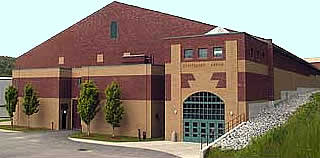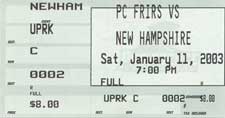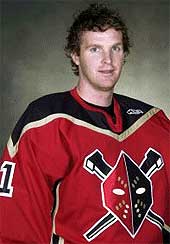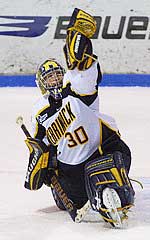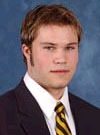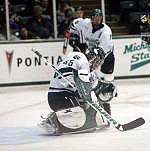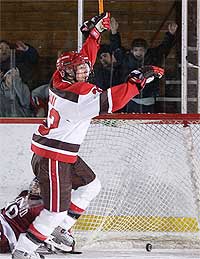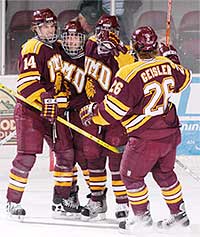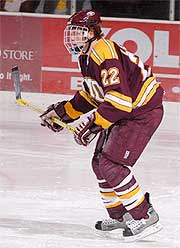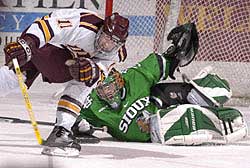Four teams gone, four teams return to action. Welcome to the quarterfinals, where the top four finishers from the regular season — bye week behind them — host best-of-three series against last weekend’s victorious quartet. Here’s how the teams stack up just one week away from a trip to Albany.
No. 8 St. Lawrence (13-19-6, 7-12-3 ECAC) at No. 1 Colgate (19-10-5, 14-6-2)
This Season
SLU 5, Colgate 1 in Canton (11/14/03); Colgate 3, SLU 2 in Hamilton (12/28/04)
Recent Playoff History:
2003 First Round at Colgate: Raiders over Saints 1-2, 3-2 (ot), 5-2
Top Five Scorers
Colgate – Jon Smyth, So., LW, 21-18-39; Adam Mitchell, Jr., F, 13-18-31; Kyle Wilson, So., C, 13-17-30; Kyle Doyle, Sr., F, 13-15-28; Darryl McKinnon, Jr., C, 10-11-21.
SLU – Rich Peverley, Sr., F, 16-25-41; T.J. Trevelyan, So., W, 23-16-39; John Zeiler, So., F, 8-27-35; Ryan Glenn, Sr., D, 7-19-26; Kyle Rank, So., F, 7-11-18.
Between the Pipes
Colgate – Steve Silverthorn, Jr., 16-7-4, 1.91 GAA, .922 save percentage
SLU – Mike McKenna, Jr., 8-8-3, 2.59, .912
An Inside Look
The Saints (4-12-2 away) enter the quarterfinals after a thrilling opening-round sweep at Yale in which both contests were decided in overtime. In a fast-paced series with a ton of shots allowed on both sides, SLU benefited from a more balanced offensive contribution and the continuing stellar play of netminder Mike McKenna. The junior has started the last 11 games for the Saints and has posted a 2.10 GAA and .932 save percentage. The fact that his record in those games is 5-4-2 is no fault of his.
“He’s seeing the puck real well,” Saints coach Joe Marsh said about his netminder. “He’s very vocal now with his defense. He’s played well in the past, but now he is playing consistently well. He’s elevated his play even in practice and the guys have a lot of confidence in him and are playing hard in front of him. One hand washes the other.”
Colgate (10-5-1 at home) returns to action after earning a first-round bye and winning the regular season title on the final night of conference play. Ironically enough, the Raiders had to beat St. Lawrence to capture the Cleary Cup. Since then, they’ve used the time off to get healthier and are focused on what they need to do this weekend.
“We’re quite thrilled with our level of consistency,” said Colgate coach Stan Moore. “But we really like how St. Lawrence plays as a team. They have a lot of emotion and play well with it. We will need to match that.
“There’s also that spoiler mentality for them coming in against us. The regular season is over and they are not that far off from the top. The game we played against them early in the year (a 5-1 loss) was one of only two games where we did not play up to the level of our opponent. We didn’t lose that game, we were beaten.
“This last game, coming down to the last seconds, we resembled a cat hanging by one claw on the toilet bowl. We had to deal with a lackluster start and fight to the end.”
Feline references aside, the Saints will have their work cut out for them as well, but are confident of how they need to play to be successful.
“That’s a tough rink to play in,” commented Marsh. “We had two different types of games against them this year, with everything going well for us in November.
“We’ll have to play at the top of our game. They are a tough team to move through the middle of the ice against offensively and you’re just not going to get many second and third chances. We have to have real good puck support, use all five of our guys and make some indirect passes. They are a good transition team.”
Over the last seven contests, St. Lawrence’s special teams have improved dramatically, especially the power play, which has clicked at a 21.8 percent rate over that span. The penalty-killing unit has been effective at 84.3 percent over the last 32 shorthanded situations.
“If you love to compete and have success, you don’t want anything less,” explained Moore about playing a Saints team that is also the healthiest it’s been all season. “You don’t want to hear that they are down nine players because of injuries, you want the test.”
This series will likely come down to depth and strong defense. Up front, each club has strong first lines. St. Lawrence’s Rich Peverley leads the ECAC in overall points (41) followed by linemate T.J. Trevelyan (39) — the league leader with 23 goals and a nation-best 13 power-play tallies — and Colgate’s Jon Smyth (39). The Raiders, however, have a more balanced attack with five forwards having scored 10 or more goals this season compared to just two for the Saints. In addition, Colgate has 11 players with 12 or more points; the Saints have six.
And while McKenna and the Raiders’ Steve Silverthorn are both on a roll, Colgate blueliners have proven more effective in their zone this year. As a team, the Raiders have allowed 2.15 goals per game (1.94 at home) while the Saints have given up 3.03 per contest — including 3.56 on the road.
Our pick: Colgate in two games.
No. 7 Clarkson (15-16-5, 8-12-2) at No. 2 Cornell (15-8-6, 13-6-3)
This Season
Cornell 2, Clarkson 2 (ot) in Potsdam (11/14/03); Cornell 2, Clarkson 1 in Ithaca (2/28/04)
Recent Playoff History
2000 ECAC Preliminary Game in Lake Placid: Big Red 4, Golden Knights 2
Top Five Scorers
Clarkson – Mac Faulkner, Jr., LW, 14-25-39; Chris Blight, Jr., RW, 17-17-34; Jay Latulippe, Jr., LW, 13-15-28; Rob McFeeters, Sr., RW, 5-16-21; Trevor Edwards, Sr., LW, 9-9-18.
Cornell – Matt Moulson, So., F, 18-16-34; Ryan Vesce, Sr., F, 10-15-25; Mike Knoepfli, Jr., F, 4-16-20; Byron Bitz, Fr., RW, 5-14-19; Shane Hynes, So., F, 9-8-17.
Between the Pipes
Clarkson – Dustin Traylen, So., 12-13-5, 2.53, .921
Cornell – David McKee, Fr., 15-8-6, 1.68, .927
An Inside Look
Like its North Country neighbors, Clarkson (7-6-2 away) is full of confidence after an opening-round road sweep in which it overwhelmed Union by a combined 13-5 score. The Knights advanced to the quarterfinals for the 41st time in the 43 years of the ECAC playoffs, but reality is about to smack them in the face.
Cornell rookie David McKee is first in the ECAC and second in the nation in GAA and second in the league and fifth in the country in save percentage. In addition, the Big Red allowed just 1.76 goals per game (second-best nationally) and killed off 88.6 percent of penalties, fifth-best in the country. With all due respect, these aren’t the Dutchmen.
Clarkson could play Cornell (6-5-5 at home) six or seven times and still not score 13 goals against the Big Red. If the Knights have any plans to win this series, they’ll need Dustin Traylen to match the goaltending prowess of McKee … and still hope for a timely goal or two.
Traylen has been the key to Clarkson’s solid play since the team lost six in a row down the stretch. The sophomore netminder is 4-1-0 since then and the team has allowed more than two goals in a game just once in that span. In addition, solid offensive efforts are coming from multiple lines now, including Jay Latulippe (held without a point just four times in 2004) and even Fairfield transfer Lyon Porter, who didn’t score a goal all season until he potted two last Friday.
“It is the first time,” said Knights’ coach George Roll, “[that] we put back-to-back solid games together. We got another strong goaltending performance from Traylen, balanced scoring and strong specialty teams play. We got a lot of good efforts from a lot of different guys.
“Dustin was Dustin. He made the key saves when we needed him to.”
Meanwhile, many seem to have forgotten that Cornell is the defending ECAC champion and must be considered a slight favorite to win in it all again. Why, you ask?
Simply put, this team knows how to win come playoff time. The Big Red have a conference-best 73 wins in the postseason (Clarkson and Harvard are second at 68) and have won a record 10 ECAC titles. Their style of play is perfect for this time of year; whether you call it “tight defense” or “clutching-and-grabbing” is up to you.
The also have the best postseason coach in the conference in Mike Schafer. Since returning to Ithaca as the bench boss, the Cornell grad has won three ECAC tourney titles and made four trips to the NCAAs.
If we were in Vegas, our money would be on the Big Red to repeat. That’s not a slight against any of the other teams who, this year especially, all have the chance to win the crown, but Cornell seems to be made for the playoffs. Last year, everything the Big Red did was with the intent of getting back to the title game against Harvard and win. They did. Would they love to repeat as champs? You bet.
Oh, and they are healthy now too.
“We’ll be dressing a fully healthy team for the first time in a long time,” said Schafer about the advantage of the week off.
“Clarkson is playing its best hockey of the year,” he continued, “and gained some more confidence by going into Union and winning. We just have to play solid defense and capitalize on our chances.
“That’s been the key difference between success or not for us.”
Roll, meanwhile, hopes for a repeat performance of the Knights’ trip to Union.
“That is the type of effort we [need] if we are going to continue to have success this weekend at Cornell. We just got done playing in that building. For our freshmen, it will not be their first taste of Lynah Rink. It is still fresh in their minds.
“I think we were a little intimidated there two weeks ago, but I don’t think that will be the case this time. We had a lot of guys step it up this past weekend and I feel pretty confident in our play going into the quarterfinals.”
All in all, this is sure to be a low-scoring series with a lot of intensity and a good level of physical play. If the games were in Potsdam, Clarkson would have a better chance, but the teams are further downstate and we just can’t see any visitor winning two of three at Lynah.
Our pick: Cornell in three games.
No. 6 Harvard (14-14-3, 10-10-2) at No. 3 Brown (15-9-5, 13-7-2)
This Season
Brown 2, Harvard 0 in Cambridge (11/01/03); Brown 2, Harvard 1 (ot) in Providence (1/31/04)
Recent Playoff History
2002 ECAC First Round at Harvard: Crimson over Bears 4-1, 2-1 (2ot)
Top Five Scorers
Harvard – Tom Cavanagh, Jr., F, 13-17-30; Tyler Kolarik, Sr., F, 10-18-28; Tim Pettit, Sr., F, 8-20-28; Brendan Bernakevitch, Jr., F, 8-15-23; Dennis Packard, Sr., F, 9-12-21.
Brown – Brian Ihnacak, Fr., F, 10-20-30; Brent Robinson, Sr., F, 11-18-29; Les Haggett, Jr., F, 5-23-28; Scott Ford, Sr., D, 6-9-15; Vince Macri, Sr., D, 6-8-14.
Between the Pipes
Harvard – Dov Grumet-Morris, Jr., 12-13-3, 2.36, .913
Brown – Yann Danis, Sr., 15-9-4, 1.70, .946
An Inside Look
What a difference a few games make. Left for dead multiple times this season, the Harvard (5-5-2 away) bandwagon is getting mighty crowded these days. The new “sexy” pick to win it all, the Crimson come into the quarterfinals having completely dominated an exhausted and shorthanded (due to injuries) Vermont team, squeezing the remaining life out of the Cats and sweeping the first round.
“When you look at it,” said UVM coach Kevin Sneddon, “you never want to make excuses, but they were a stronger team. We just had too many injuries and our tanks were running low going into the series. I hate losing more than anything, but [it] was a big step forward for our program.”
How’d Harvard finish them off?
Timely goals, excellent penalty killing and a little thing called the neutral-zone trap. That combination does wonders in the postseason: just ask the New Jersey Devils. The Crimson intended to ride it all the way to the Pepsi Arena in Albany — coincidentally the home of the Devils’ AHL franchise.
“One of the real keys to the whole weekend,” said Harvard coach Mark Mazzoleni after beating the Cats, “[was] the penalty killing. And at five-on-five, we pretty much had the advantage all weekend.”
On his team’s improved and emotional play, Mazzoleni had a simple explanation.
“It’s hard to have good chemistry and fun when you’re not winning. It’s good to see the players rewarded for all of their hard work.”
Ah, but let’s not forget about the Brown Bears (8-3-2 at home). In first place for the majority of the season until a February slide dropped them into the third slot, the week off may have helped Brown regain its focus.
“I thought we played some pretty good hockey [down the stretch],” said Bears’ coach Roger Grillo, “but we didn’t get the results we wanted. We’re ready to go and very confident going into the series. Harvard is a good team, but we have to do what we do best: play hard, smart and disciplined.”
Hosting their first playoff series against Harvard after seven series losses at Bright Hockey Center, the Bears are still the most dangerous team in the league if, for no other reason, than they have Yann Danis between the pipes. The best netminder in the ECAC, he can win games all by himself and has done so throughout his career. As a senior, he’s extra motivated — if that’s possible — to go out with a bang.
Danis doesn’t just make big saves, he makes momentum-shifting stops, especially on the power play. Coaches say that a team’s best penalty killer is its goalie, which explains the Bears’ 90.7 percent PK effectiveness that ranks them atop the national statistics.
“Some of the older guys have stepped up too,” said Grillo. “including [defensemen] Vince Macri, Scott Ford, Gerry Burke and Paul Crosty.”
On offense, the Bears are improved over last season, including a 21.3 percent conversion rate on the power play, which ranks seventh in the country.
The Crimson, while holding down Vermont, still took some ill-advised penalties. That’s something it can’t afford against Brown, which has scored 33 of its 76 tallies this season with the man-advantage. Harvard will want to keep the game at even strength, where it has allowed only two goals while playing five-on-five in the last four games.
Expect another big series from the Crimson’s Tyler Kolarik, whose ECAC playoff totals for his career include six goals and 19 points, while Ryan Lannon and the defensive unit attempt to shut down Brown rookie Brian Ihnacak and upperclassmen Brent Robinson and Les Haggett.
And how does Grillo expect to break Harvard’s trapping style?
“We need to be patient and take care of the puck. We don’t want to force the issue … we don’t want to be in that position.”
This should be another close, low-scoring series. It’s a tough call on which way it will go, but, despite Harvard’s renewed confidence and aggressiveness, we keep getting lured back to the Bears’ side because of Danis and their strong play at Meehan Auditorium.
Our pick: Brown in three games.
No. 5 Rensselaer (21-13-2, 13-8-1) at No. 4 Dartmouth (12-8-9, 10-5-7)
This Season
Dartmouth 1, RPI 1 (ot) in Troy (11/15/03); Dartmouth 4, RPI 3 in Hanover (1/30/04)
Recent Playoff History
2002 ECAC Preliminary Game in Lake Placid: Engineers 2, Big Green 1
2001 ECAC First Round at Dartmouth: Big Green over Engineers 4-2, 5-1
2000 ECAC First Round at Rensselaer: Engineers over Big Green 7-2, 3-2 (ot)
Top Five Scorers
RPI – Kevin Croxton, So., F, 18-21-39; Kirk MacDonald, So., F, 14-18-32; Nick Economakos, Jr., F, 9-19-28; Scott Basiuk, Sr., D, 10-15-25; Ben Barr, Sr., F, 8-15-23.
Dartmouth – Hugh Jessiman, So., F, 16-16-32; Lee Stempniak, Jr. F, 14-18-32; Grant Lewis, Fr., D, 3-22-25; Mike Ouellette, So., F, 13-8-21; Nathan Szymanski, Jr., F, 9-12-21.
Between the Pipes
RPI – Nathan Marsters, 20-11-1, 2.12, .920
Dartmouth – Dan Yacey, Jr., 11-8-8, 2.64, .906
An Inside Look
How odd a year has this been? Dartmouth (6-2-4 at home) finished the regular season with three fewer wins than Rensselaer’s 13, but won the higher seed in a tiebreaker. You can thank the Big Green’s seven league ties to RPI’s one for pulling it even in points and winning percentage. The tiebreaker was head-to-head record and it gave Dartmouth the first-round bye.
“It was good to have the week off,” said Big Green coach Bob Gaudet. “We were banged up and heading into finals, so we were able to get some academic work done. It’s a tough time of year for us with finals and the playoffs. We’re healthier now.”
Continuing along the pathway of the strange, the Engineers (12-6-0 away) have nine more wins than their opponents this weekend and are the only ECAC club with more than 20 victories. Of course, all that gets them is the third-best overall winning percentage among conference mates and a road series in Hanover — which RPI earned after sweeping Princeton in the opening round for its first four-game winning streak of the season.
All that aside, these two teams line up pretty evenly in some other statistical categories, including special teams, where Rensselaer ranks slightly better in power plays (20.5 percent to 19.4) and penalty killing (85 to 78.8).
“They are a really good team,” said Gaudet. “They have had a great season and Marsters has been outstanding in goal. They are a good offensive team and excellent defensively; they present a lot of challenges for us.”
A strong road team, RPI plays a tough, physical style that makes it dangerous regardless of the opponent. The Engineers, and this may come as a surprise to many, lead the ECAC in overall scoring with 113 goals and 3.14 tallies per game. Defensively, they allow a fourth-best 2.25 per contest. Across the ice, the Big Green rank fourth in offense with a 2.90 scoring average — down from 3.74 last season — and seventh in defense, allowing 2.86 per game.
Dartmouth and RPI are also similar on the blueline with Rensselaer senior Scott Basiuk and sophomore Brad Farynuk playing similar roles to Dartmouth’s senior Brian Van Abel and rookie sensation Grant Lewis — who would have had to sit out with an injury were it not for the bye week. Gaudet also admitted that this weekend marks the healthiest Van Abel has been in quite some time.
However, where the series will likely be decided is between the pipes. Marsters has strung together an excellent final season in Troy and has been a quiet force in goal — winning 20 for the first time and posting a career-high five shutouts. For Dartmouth, junior Dan Yacey enters his first postseason as the go-to guy. He began the season on a tear, leading the Big Green to a 4-0-3 start, but was as inconsistent as his teammates up until February. Over a 20-day span last month, he was 3-0-2 before losing the season finale at Harvard.
“It really doesn’t matter who we play,” Gaudet said. “We have to play hard, stay out of the box and generate offense. We really need to focus for every shift.
“It should be fun. It is a great time of year to be playing and we are very excited to be playing them at home.”
In such a close series, home ice usually is a factor, but RPI’s excellent performance away from the Capital Region could nullify Dartmouth’s Thompson Arena advantage. RPI has won five straight road games, allowing just two goals or fewer in those contests, and is 6-1-0 in its last seven away from home. That lone loss? To Dartmouth, of course.
That said, and with all other aspects fairly even, the series will come down to who plays better in goal and our money is on Marsters, the tested playoff veteran of every RPI postseason game (13) in his four-year career.
Our pick: RPI in three games.
Rangers May Dip Into ECAC
Those of us who have been longtime observers of the National Hockey League are still a bit surprised to see the New York Rangers finally undertaking a rebuilding effort. Cursed in unimaginable ways after seemingly selling their franchise’s soul for the 1994 Stanley Cup, the Blueshirts spent the days leading up to the NHL’s Tuesday trade deadline unloading most of their marketable dead wood: Alexei Kovalev, Brian Leetch (!), Petr Nedved, Chris Simon et al.
The Rangers are serious — for now — about remaking the club, so much so that the ECAC, of all leagues, could feel the effects.
The New York Post recently reported that the Rangers’ mess in goal is leading them to explore a series of alternatives to Mike Dunham and Dan Blackburn — the one-time “franchise” netminder. Apparently, the Rangers have their sights set on Brown’s Yann Danis, a free agent once the Bears’ season ends. They’ll have competition for Danis, though, as the Post claimed that at least six other teams are interested in the netminder.
In a surprise to no one, the Rangers are also expected to try and sign Dartmouth’s Hugh Jessiman at season’s end and place him with their AHL affiliate, the Hartford Wolfpack. Drafted last summer by the Blueshirts, Jessiman didn’t hide his excitement when he visited Rangers training camp at UVM before the season. The big sophomore never participated in camp. According to the Post, Rangers management is intent on signing him to a contract “as quickly as possible.”
A Broken Neck and A Black Eye
Baseball and hockey have always been my favorite sports. They shared the number-one spot in my heart for years until hockey finally took the lead. I love the game, the strategy, the speed, the physical aspect, the finesse … all of it. I’m as happy at a 1-0 defensive battle as I am at a 7-6 shootout.
As hockey fans, we defend our sport, all the while wondering why others don’t get as fired up as we do each night. And then it happens. All of the stereotypes about hockey get reinforced with one cheap shot that gets replayed as often as a passionate 10 seconds of a Howard Dean speech.
Thank you, Todd Bertuzzi.
He and his Vancouver Canucks have had their sights set on Colorado’s Steve Moore since the former Harvard Crimson KOed Markus Naslund with a shoulder to the head. The hit was finally “avenged” this week when Bertuzzi, his team getting blown out at the time, sucker-punched Moore from behind, then, using the force of his 245-pound frame, drove the Avalanche center’s head into the ice — fracturing Moore’s neck.
Nice.
One of the most interesting aspects of hockey is how the game polices itself, so you knew retribution was coming against Moore. But what Bertuzzi did wasn’t just inexcusable, it was appalling.
It’s one thing if Bertuzzi wants to skate up to Moore and drop his gloves — Moore was involved in a first period fight, by the way — but for the league’s best power forward to jump a smaller player from behind is pathetic and cowardly.
What’s worse is that the premeditated play — encouraged by Vancouver coach Marc Crawford — could have killed or paralyzed Moore. Did Bertuzzi intend to break Moore’s neck? Not likely. Did he intend to hurt Moore? Absolutely. And for that, Bertuzzi needed to be punished accordingly. Forty games. A full season. Something harsh.
Unfortunately, the NHL took the cowardly way out also. On Thursday the league suspended Bertuzzi for the remainder of the regular season and the playoffs — a minimum of 17 games. Commissioner Gary Bettman said he’ll decide on further punishment at next year’s training camp when he sees how Moore has progressed. Of course, with a lockout looming there may not be a training camp in the fall.
What’s worse is that the punishment shouldn’t be dependent on where Moore’s recovery is in a few months. Bertuzzi’s punishment should be based on the act, not on whether a miracle saved Moore’s life, his mobility and his career.
Once again, the NHL proved it doesn’t want to be taken seriously. It turned away from its responsibility to all of hockey and because of that, more than anything else, the sport as a whole is worse off.
Our Two Cents …
Princeton fired head coach Len Quesnelle earlier this week, which opens up a vacancy in a league known for hiring from within. The Tigers announced that they will have a national search for a new coach, but their best bet may already be toiling in the conference. If Princeton is serious about bringing its program back to respectability and future success, we think the powers that be need to call Stan Moore as soon as Colgate’s season is over.
The Raiders’ interim head coach took over for Don Vaughan weeks before the season began, lifted his club out of its emotional shock and led Colgate to its first regular-season title since 1991.
“We had some seniors in tears trying to deal with the change,” said Moore, recalling last fall. “They had a picture of what their last year would be like. I leaned on my wife and we chatted about it. We always say, ‘Intelligence is the ability to adjust,’ and softly, we had to say it to the players.”
Moore’s performance this year has not been a fluke.
In his first season at Union (1996-97), Moore took a seven-win team and led it to an 18-13-3 record. That total still stands as the most wins in any of the program’s Division I seasons and is the last time Union finished above .500.
Moore and the Dutchmen struggled through a 6-22-4 season in his final year in Schenectady. But aside from that blemish, he’s won 37 games in two seasons under tough conditions. That’s certainly worthy of consideration.
In Case You Missed It
Clarkson’s victories at Union marked the first time this season that the Knights earned a pair of wins on the same weekend from an ECAC team.
Golden Knights co-captains Tristan Lush and Rob McFeeters sat out last Friday’s game against the Dutchmen when they took responsibility for a violation of team policy committed by several other Clarkson players. It was the first game Lush has missed in his collegiate career.
Knights junior Mac Faulkner is one point away from being the first Clarkson player to score 40 points since Erik Cole notched 41 in the 1998-99 campaign.
(Tastiest) Stat of the week: Harvard is undefeated at home in the playoffs (8-0-0) when Assistant Director of Athletic Communications Jamie Weir provides baked goods (her homemade cakes) in the press box. Now there’s a superstition we can all rally behind.
Eight of the 30 power play goals allowed on the season by the Crimson were scored by Vermont.
The Crimson’s Dov Grumet-Morris set a modern school record for consecutive shutout minutes with a streak of 184:35 into the third period of game two of the UVM series.
With Friday night’s win, Rensselaer reached the 20-win plateau for the fourth time in the last six seasons.
St. Lawrence’s sweep of Yale marked the first time since 1964 that the Saints have advanced as a road team in the ECAC playoffs and the two wins were the third and fourth for SLU as a visiting team in their tournament history.
What’s on Tap
No. 8 St. Lawrence at No. 1 Colgate: St. Lawrence leads the overall series between the two teams by a 56-51-3 margin, but Colgate holds the edge at home 27-21-2. The Saints have won just twice in their last 11 trips to Starr Rink.
No. 7 Clarkson at No. 2 Cornell: Clarkson leads the all-time series 44-42-9, but Cornell boasts a six-game unbeaten streak (5-0-1) and an 8-1-1 mark over the last 10 games. The Knights have not won at Lynah since March 1999. Clarkson’s most familiar opponent in the ECAC playoffs, the Knights and Big Red have played 19 times with Cornell owning a 12-6-1 lead.
No. 6 Harvard at No. 3 Brown: Harvard leads the all-time series with Brown by a 96- 36-8 margin, with the Bears winning both games this season. Roger Grillo is 6-9-1 against the Crimson, while Mark Mazzoleni is 7-5-0 against Brown. The Harvard bench boss improved his ECAC playoff record to 12-4-0 with the sweep over UVM. The Crimson also own a 6-1-0 record against the Bears in tournament history, which includes a perfect 5-0 mark in quarterfinal matchups.
No. 5 Rensselaer at No. 4 Dartmouth: Rensselaer leads the overall series 33-19-4, but Dartmouth has had the upper hand of late, posting a 4-1-2 mark over the last seven head-to-head matchups. Rensselaer head coach Dan Fridgen is 14-10-2 in his career against the Big Green.
